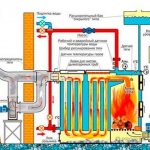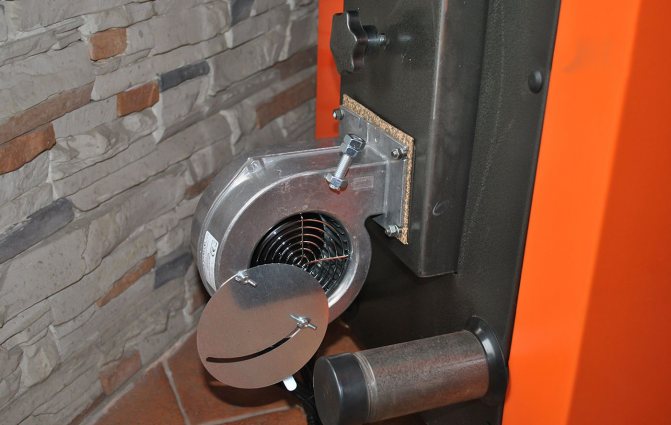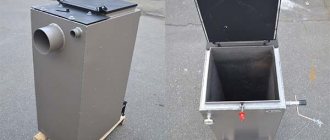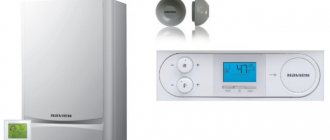Home / Solid fuel boilers
Back to
Published: 27.02.
Reading time: 5 min
0
368
The blowing fan is mounted on a solid fuel boiler to optimize the combustion processes, which leads to an increase in the efficiency of the thermal circuit and fuel economy.
A fan for a solid fuel boiler can be made independently, which will allow the owner to save significant funds on the purchase of a factory analogue.
- 1 Purpose of the fan for the boiler
- 2 Design and principle of operation
- 3 Varieties 3.1 Electro-commutated motor
- 3.2 Synchronous motor
- 3.3 Asynchronous motor blowers
What is a fan for? Its main functions
A solid fuel boiler in the usual view is a heating device, where the main work is carried out due to the combustion of fuel. In the presence of draft and natural air flow, the combustion intensity is weak, respectively, low heat transfer. An example is a fireplace. The natural flow of air does not allow the flame to flare up strongly in the firebox, therefore this heating device has limited technological capabilities.
It is quite another matter when the supercharger is turned on. An additional volume of air is pumped into the furnace of the heater. Combustion becomes intense, the fuel burns out completely, giving up the maximum amount of kilocalories.
Therefore, for modern models of solid fuel boilers, of almost all types and types, the fan is one of the most important elements of the control system. Usually, the set of automatic heating devices today includes a blower, a smoke exhauster and a control unit. Competent and correct installation of such devices and devices on the boiler equipment will provide your unit with reliable and balanced operation.
On a note: the combustion process is 90% dependent on the operation of the blower. Thanks to the action of this device, air is injected into the combustion chamber, the combustion intensity increases, and the efficiency of the heating equipment increases accordingly.
Today, domestic and foreign industry produces a huge number of household fans (coolers), specially designed for installation on heating devices. When choosing a blower for your unit, you need to focus on the power of the boiler and your own, everyday needs. A solid fuel unit with a fan is a high-tech and efficient heating machine. All processes, from the extraction of flue gases to the best performance of the combustion chamber, depend on the operation of the fans.

Purpose of the smoke exhauster
A high-quality chimney, good draft are the conditions that ensure long-term and correct operation of the boiler. Efficient removal of combustion products is a prerequisite for maximum efficiency with full combustion of solid fuels. Therefore, the correct design and construction of the chimney is of great importance. Errors lead to the fact that the thrust is not sufficient and stable.
A smoke exhauster for a solid fuel boiler is imperative if natural ventilation in the chimney is not enough. However, his installation allows you to solve a number of other tasks
:
- Reduced fuel consumption.
- You will have to clean the chimney from soot and tar less often.
- Minimizing the risk of burning and smoke entering the room.
- Increasing the efficiency of the boiler, ensuring its stable operation.
- The ability to more accurately control the heating temperature of the coolant.
- Getting rid of the specific smell that appears during the operation of the boiler.


Exhaust fan, as an integral part of a solid fuel boiler
In addition, the smoke exhauster provides comfortable conditions during the laying of firewood, as it prevents the accumulation of smoke in the furnace. So, when the main door is opened, there will be no release of combustion products into the room.
It is important that a powerful smoke exhauster will allow you to get rid of smoke and soot even in adverse weather conditions (precipitation, strong wind). Smoke exhausters for domestic boilers are mounted at the end of the gas-air duct
The purpose of the traction machines is to provide a vacuum in the furnace. This is necessary for the normal operation of a solid fuel unit. Boiler room equipment with blower fans will be more expensive and from a technical point of view, this solution is much more complicated.
Smoke exhausters for domestic boilers are mounted at the end of the gas-air duct. The purpose of the traction machines is to provide a vacuum in the furnace. This is necessary for the normal operation of a solid fuel unit. Boiler room equipment with blower fans will cost more and from a technical point of view, this solution is much more complicated.
Device device and types of fans
According to their functional characteristics and parameters, fans are divided into three types, each of which is determined by the design of the engine. The electric motors used for these purposes can operate on both alternating and direct current. The advent of electronic equipment created the preconditions for the active use of AC motors. Unlike DC motors, AC motors have virtually no disadvantages. The simple and unpretentious design of electric motors has made it possible to establish mass production of a wide variety of electromechanical devices. Most of the fans are equipped with just such electric motors.
The following types of fans can be found on the market today:
- devices in electrically commutated motors (EC);
- products equipped with synchronous motors;
- asynchronous motor blowers.
All products have their own clear advantages and disadvantages. In the case of an electrically commutated motor, we can talk about one quality. The device itself is capable of changing the number of revolutions, receiving a corresponding signal from the control unit. Here we can talk about a wide range of fan operation control. However, the device has a significant drawback - the device is not compatible with most domestic temperature controllers. In addition, this technique is expensive in price.


Speaking about fans with synchronous electric motors, we can focus on the following: the devices are quite cheap and easy to manufacture. However, this type of equipment has certain disadvantages. Such devices have a minimum torque during start, and a small range of speed control.
For reference: usually fans with synchronous motors are used to continuously pump air mass into the combustion chamber. Synchronous motors, which the devices are equipped with, are rather large in size. Typically, the blower motor is housed in a separate unit. When operating at low speeds for synchronous motors, overheating of the winding is frequent.


The latter, the third type of fans used in modern heating systems, has a number of advantages. The asynchronous electric motor makes it easy to adjust the number of revolutions. On some models, there is even a ravers. The main advantages of such a device are as follows:
- Such fans are simple and easy to use;
- They have a reliable design;
- Conventional control scheme;
- Supported by all currently available MRI.
The only drawback that induction motors have is their high starting currents.
Types of smoke exhausters
If a chimney shaft is built in your house, the draft of which is not enough for the functioning of a new heating unit, then the simplest smoke exhauster for the boiler will help to solve this problem. It is not at all necessary to immediately purchase electromechanical devices; it is enough to install a special deflector at the end of the pipe, which creates additional natural thrust. But when all such options have been tried, you can purchase and install one of the proposed devices:
- fan - natural draft amplifier;
- flow-through smoke exhauster;
- centrifugal traction machine.
A traction amplifier is a device equipped with an axial fan, it is placed at the end of an exhaust shaft or pipe. The performance of the device can be adjusted manually using the thyristor control unit.
Flow-through smoke exhausters for boilers are installed immediately at the outlet of the unit and also serve to increase the thrust force. The design of the apparatus is such that only the impeller is located inside the smoke channel, which does not overlap its cross section. The electric motor and other elements are located outside, which allows the device to be turned on when necessary, and the rest of the time the mine can successfully remove smoke using natural draft. You can control the switching on and performance of the device both in manual mode and in automatic mode by connecting it to the automation of the boiler plant.


In fact, this type of smoke exhausters cannot always serve as a full-fledged traction unit, but only as an exhaust amplifier. The reason is the insufficiently high pressure developed by the impeller of the apparatus due to its design. To get a good result, it is better to put a centrifugal smoke exhauster on a solid fuel boiler. In this case, the control of all functions of the device should be tied to the electronic unit of the heat generator, then the operation of all elements of the system will be coordinated. In addition, centrifugal fans are able not only to create a vacuum in the combustion chamber, but also to develop high pressure, which will force any chimney to work.


In heating units of high power, a forced draft-blowing circuit with two fans is used, this is an ideal option. But the implementation of such a scheme is associated with certain difficulties, since for a balanced operation of the system, it is required to calculate the exhaust fan and blower, the amount of air for combustion and the resistance of the entire gas-air duct, including the exhaust duct.
Classification of solid fuel boilers
The market today offers the widest selection of models with a buffer tank, solid fuel boilers, both domestic and foreign. Components for solid fuel boilers are also widely represented. They can be used both for operation only for the heating system and for heating a boiler for domestic needs.
- by the material from which they are made:
- steel - products are much cheaper than cast iron boilers, easier to clean and maintain. But they are very sensitive to the temperature value in the return circuit (not lower than 60 degrees). Therefore, they require the installation of a block of special boiler valves, which are a kind of control element and maintain the required temperature in it by mixing the coolant from the supply line into the "brother";
- cast iron - more durable, but more difficult to maintain. Recommended only for continuous year-round use.As a backup unacceptable, too expensive;
- by the type of fuel used:
- peat, firewood, woodworking waste, derived from them, supplied in special briquettes;
- pellets (special granules resulting from the processing of needles, resin and other organic matter);
- coal;
- universal "all-fuel" equipment;
- by the implemented method of heat transfer:
- water boiler (most commonly used);
- steam boiler;
- air boiler;
- according to the principle underlying fuel combustion:
- traditional way;
- long burning - the latest developments and innovative solutions implemented in heating technology have been used. Structurally, they are designed in the form of a vertically elongated firebox (firebox) around which a water jacket is located, with a control unit.
What is long burning
The specificity of the principle of long burning is that the fuel burns from top to bottom (analogue of a candle), which ensures more complete combustion and increases the burning time of each bookmark. In some models with a buffer capacity, it can reach almost seven days. At the same time, a decent efficiency, high and stable temperature of the water in the boiler, which plays the role of a heat carrier, is ensured.
To ensure safe and uninterrupted operation, the boilers of these blocks of systems have smoke exhausters, special fans for a solid fuel boiler intended for emergency extinguishing, a circulation pump built into the heating system and safety valves (and accessories for them), as well as control units.
Fig. 2 Centrifugal smoke exhauster
All boilers of this type have pre-installed automation, which also includes a fan for a solid fuel boiler. This means that they need a source of electricity.
Fig. 3 Household smoke exhauster
In order to understand what kind of components with a fan you may need for a medium or overhaul of an installed boiler with a factory-made fan, or for its self-production, you need to have an idea of its structure and the principles underlying its work.
Making a pyrolysis boiler
The effectiveness of this type of wood-fired installations has become the reason for their popularity among craftsmen who can make solid fuel pyrolysis-type boilers on their own from available materials. This process is quite laborious and requires the skills of performing locksmith and welding works, a certain minimum of tools and equipment:
- apparatus for electric welding;
- angle grinder;
- electric drill;
- set of locksmith tools.
If you have the skills, tools and a great desire, then you can make a unit using the following drawing of a natural-draft pyrolysis boiler:
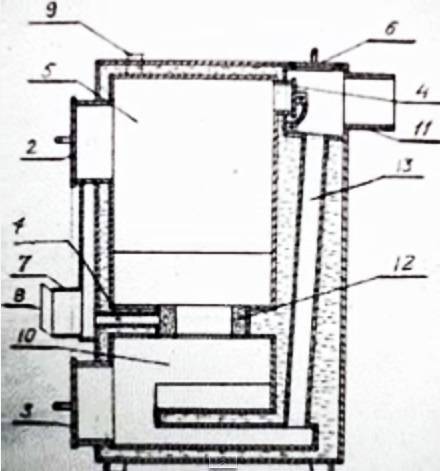

1 - air channel; 2 - door for loading fuel; 3 - door of the secondary chamber; 4 - direct draft damper; 5 - primary chamber; 6 - top cover; 7 - inlet channel for air supply; 8 - air damper; 9 - branch pipe for the safety group; 10 - secondary combustion chamber; 11 - chimney connection pipe; 12 - nozzle; 13 - fire tube heat exchanger.
Heat-resistant alloy steel can serve as a material for the manufacture of chambers, but this is an expensive material, so the craftsmen take simple carbon steel 5 mm thick. To protect it from high temperatures, the pyrolysis boiler is lined with refractory bricks in the lower part of the furnace.They also need to protect the bottom of the secondary chamber, where the flame is directed. For sheathing the water jacket, sheet metal with a thickness of 3 mm is used, it is welded to stiffening ribs made of strip steel. Doors, cover and frame of openings are made of the same metal.


The boiler device provides for the transfer of heat from flue gases through a fire-tube heat exchanger located inside the water jacket. For its manufacture, seamless carbon steel pipes with an outer diameter of 48 or 57 mm are suitable. The number of pipes should be selected according to the required area of the heat exchange surface, for which the calculation of the pyrolysis boiler is performed.
Considering that the fuel in pyrolysis units burns for a long time (up to 12 hours) and efficiently, some owners of classic direct combustion units are thinking about whether they can be upgraded. Such a conversion of a solid fuel boiler into a pyrolysis boiler is possible, but provided that the furnace of the unit is made of metal, not cast iron. The grate is removed and, using electric welding, a partition is fixed in its place, separating the main firebox and the ash pan, which will act as a secondary chamber. A nozzle is installed between them. In addition, it will be necessary to organize the supply of air to both chambers, it is necessary to make air ducts and install them, as shown in the drawing.
As a rule, the conversion of a boiler into a pyrolysis boiler does not occur at factory units, but at home-made ones, this expands the possibilities for improving the design. It is possible to change the flow area of the nozzle, the dimensions of both chambers or the surface heat exchange area, achieving the best indicators of the duration of combustion and increasing the efficiency of the installation.
Solid fuel boiler device
Firebox
It is the main element of any component equipment that performs a dual function: a heat exchanger and a combustion chamber.
Detailing its design, it should be noted that the product has:
- exhaust fan opening, providing air access to the combustion site;
- ash pan;
- grate grate;
- domed upper part of the smoke exhauster (for collection and subsequent removal of gases and combustion products that are in the volatile stage);
- a portal through which fuel is supplied.
Combustion in the furnace, solid fuel heats up the walls of the equipment with a fan and heats the water to a high temperature, which is in the water jacket of the boiler with a buffer tank. For better performance, it is often equipped with a smoke exhauster.
Water jacket
In almost all models of solid fuel equipment with a fan, the shirt is located between the double walls of the firebox. The water acting as a heat carrier (in the overwhelming majority of cases), passing through the jacket, takes heat from the firebox, thereby protecting it from overheating, and carries it to the heating system. Hot water leaves the jacket through the pipes of its upper part, and the water cooled down in the system enters the jacket through the lower pipes.
Solid fuel equipment with a fan is capable of operating when the coolant moves along the heating system lines by gravity (the so-called open systems). Although technically it is possible to equip boilers with circulation blocks and pumps of various capacities and capacities (in this case, you always need to have the necessary components for them). The presence of system blocks significantly increases the heat transfer of the unit.
Despite this, open systems with a fan are in high demand, as they are independent of external power supplies, economical and very reliable. Equipment with a buffer tank equipped with a fan, used not only for heating the premises, but also for providing consumers with hot water, have boilers connected to them and must be equipped with a control unit.
Gas removal system
A lot of smoke is generated inside a boiler with a fan during the combustion process. Therefore, if you do not provide it with a properly working smoke exhauster, all this will get inside the room. As a rule, the role of a chimney is performed by heat-insulated pipes that remove combustion products outside the building. Smoke exhausters and / or a fan for a solid fuel boiler are often installed here.
Temperature control and monitoring unit system
A constant supply of fresh air by the smoke exhauster to the combustion site is a prerequisite for any combustion process. The more air flow, the more intense combustion can be achieved.
That is why, the design of any solid fuel equipment necessarily has mechanical gates and dampers used to regulate the air supply (and components for their prompt repair and replacement). Smoke exhausters are often installed.
Fig. 6 UPS for solid fuel boiler
Control unit systems based on the use of such control methods are simple and very reliable. The smoke exhauster damper is specially fixed on the regulator. When the set temperature is significantly exceeded, the walls of the regulator expand, which leads to a lowering of the damper (the flow area of the supply air duct decreases), which contributes to the cooling of the furnace and protects it from overheating.
During the reverse process, the walls of the regulator, respectively, are compressed and initiate the rise of the damper. The burning intensity increases again.
Despite the very venerable age of this technical solution, it still remains one of the most effective and efficient. Therefore, it is implemented in the vast majority of models of solid fuel boilers. Although new models often have special systems and a control unit for them.
Features of using smoke exhausters
When choosing a traction smoke extractor, it is necessary to calculate the cross-section of the exhaust pipe and the capacity of the exhaust unit. Unlike injection installations, they are more versatile and efficient, they allow you to lay firewood during the operation of the boiler, and do not allow combustion products to enter the room.
Forced extraction of flue gases will help to make the stay in the room safe and reduce the risk of carbon monoxide poisoning to a minimum.
The use of smoke exhausters for pellet burners or boilers operating on sawdust, peat is the only possible way to organize the heating process. Under normal conditions, they burn badly.
Advantages of using a chimney hood:
- Improving the efficiency of heating devices, firewood burns almost without residue;
- Eliminates the accumulation of smoke in rooms, eliminates unpleasant odors;
- Exhaust gases do not flow back into the room when the firebox door is open;
- Reduce deposits on the walls of chimneys due to the filtration and separation system.
They have practically no drawbacks. If no mistakes were made during installation, then the service life of the smoke exhauster in the chimney is comparable to that of the boiler itself. In this case, regular maintenance should be carried out.
What components and assemblies may be required for self-manufacturing of the boiler or its repair
Components for solid fuel boilers have varying degrees of demand. Some are guaranteed to serve until the boiler is decommissioned. The latter have a certain resource. It is about the latter that will be discussed below.
First of all, it is required to provide guaranteed, protection of the solid fuel boiler from overheating. In this case, it is necessary to take into account the inertia of fuel combustion inherent in solid fuel boilers, the presence of which excludes the possibility of a safe shutdown of the entire control unit system until the fuel is completely burned out.You cannot stop the process of burning wood or coal, you can only reduce the intensity of combustion. This is what determines the need for mandatory protection against possible overheating.
Protection of a solid fuel boiler from overheating is carried out by using the following technical solutions:
a. cooling heat exchanger
Through the installed thermal valve, which is a control element, the cold coolant is supplied to this product, which does not lose its performance almost to 95 degrees above zero. When the equipment warms up to the set limit temperature, the thermal valve is triggered and the coolant is redirected to the heat exchanger, where it is quickly cooled by the fan to the permitted level. The cycle is repeated until the water temperature drops to +60 degrees.
Fig. 7 UPS for boilers
The heat exchanger can be structurally built into the boiler, or mounted between the heating system and the outlet of the water heater. The use of this method initially provides for the presence of an irreducible required supply of cold coolant. In the event of an emergency shutdown of the unit without such a protection system, it may fail due to overheating. That is why it is very important to make sure of the quality of all components.
b. switching valve
The shut-off (aka changeover) valve (control element) is used to cut off (block) the water supply when the boiler overheats. As soon as the temperature of the coolant in the system exceeds the permitted one, it is drained into the sewer. At the same time, cold tap water is supplied to the boiler. In order for it to be guaranteed to enter the supply pipe system, it must be supplied at a certain pressure (up to 3 bar).
Automation for solid fuel boilers
This group of equipment with a fan combines control units and fans. Currently, you can select both the first and the second with the parameters required for your boiler. Thanks to the buffer capacity, namely the indicated structural elements in the heating system, it is possible to maintain a given temperature without the constant presence of a person.
Control block
Thanks to the use of a solid fuel boiler control unit, the heating control system in your home can be fully operated in automatic mode. At the same time, the set temperature is maintained in the system with a buffer tank.
The solid fuel boiler control unit is selected taking into account the brand of the product you have installed and monitors the correct functioning of the fan and the built-in circulation pump (if the latter is available).
Fans
A fan for a solid fuel boiler is the second most important device used to automate a boiler control system with a fan. Some fan models are called turbines. They pump air into the combustion chamber (into the furnace) of the boiler and are used to ventilate the used technological equipment with a buffer tank, different rooms, and to stabilize the temperature.
Draft regulators
This is the third group of products with a fan related to the means of automating a solid fuel boiler. Nonvolatile draft regulators in their traditional design are widely used in solid fuel equipment. They are easy to install. They are easy to operate. They are reliable and affordable.
These devices with a buffer tank are used to adjust the temperature of the water (another heat carrier) circulating in the heating system, which is carried out by changing the position of the damper depending on the required temperature. Accordingly, the supply of air to the combustion site increases or decreases. This affects the speed and intensity of combustion, and through this, the temperature of the coolant in the line.
The use of such regulators with a buffer tank makes it possible to increase the efficiency of boilers by 15 - 20 percent.
Design and principle of operation
Regardless of the manufacturer, the fan consists of an aluminum or galvanized casing, inside which there is an electric motor, guide blades and protection, in the form of a lattice fence.


This design, with its simplicity and small dimensions, is reliable. A damper is installed on the blower, which is designed to limit the penetration of flue gases into the combustion room in the event of a reverse draft.
Also, the damper reduces natural draft when the air is not being supplied.
The connecting pipes can be located in the upper part of the casing or on the front part of the blowing unit and have different shapes of connectors for connecting to the boiler. Algorithm of functioning of the boiler control system using blast air:
- the heating device is filled with solid fuel and ignited;
- the blower turns on and the air flow is regulated;
- when air is supplied to the combustion zone, intensive combustion of the fuel begins, and therefore, the temperature of the coolant begins to rise;
- when the temperature reaches the set value, the controller of the control unit gives a signal to turn off the blower;
- air shortage will lead to a decrease in the intensity of fuel combustion and a decrease in the temperature of the coolant.
Uninterruptible Power Supplies (UPS)
The source of a UPS (uninterruptible power supply) for equipment operating on solid fuels, otherwise called an uninterruptible power supply, is selected taking into account the total electrical power required for it.
In the simplest version, when the version of the installed boiler has manual fuel loading, the oxygen supply to the combustion site is regulated by a mechanical rotation of the blower gate, and the system operates due to the temperature difference between the supply and return heat carrier, only the energy consumption of the circulation pump will be considered. In this case, the power of an uninterruptible boiler for a solid fuel boiler is calculated taking into account the number of pumps, their power, the likelihood of simultaneous switching on, etc.
This is the first component of the assessment. The second is due to the fact that in case of a possible prolonged power failure from the external network, an uninterruptible power supply for a solid fuel boiler (UPS) must guarantee the operation of the boiler during the entire shutdown period, which can be several hours.
Taking into account all of the above, the uninterruptible power supply of the following models is considered the most acceptable for solid fuel boilers:
- uninterruptible power supply line-interactive (for example - INELT Intelligent 500LT2) with one or two batteries;
- UPS with double conversion (East EA910 LCDH type).
Purpose of blowing fans
Blowing fans are used in all boiler houses for boiler units operating on all types of fuel (including gas-oil, pulverized coal boilers), at thermal power plants, as well as in technological lines in various industries, in the production of ferrous metals. They are used to supply clean air and can move air masses with temperatures ranging from –30 to +80 ºС. Can supply air to gas burners of blast furnaces. Installed indoors and outdoors - under a canopy (to protect the engine). Designed for continuous continuous operation. In the air masses moved by the fan, the presence of explosive substances and solid dust impurities in concentrations of more than 0.1 g / m3 is not allowed.
